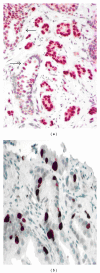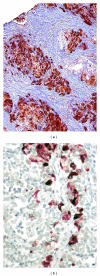Factors implicated in radiation therapy failure and radiosensitization of prostate cancer
- PMID: 22229096
- PMCID: PMC3200271
- DOI: 10.1155/2012/593241
Factors implicated in radiation therapy failure and radiosensitization of prostate cancer
Abstract
Tissue markers may be helpful in enhancing prediction of radiation therapy (RT) failure of prostate cancer (PCa). Among the various biomarkers tested in Phase III randomized trials conducted by the Radiation Therapy Oncology Group, p16, Ki-67, MDM2, COX-2, and PKA yielded the most robust data in predicting RT failure. Other pathways involved in RT failure are also implicated in the development of castration-resistant PCa, including the hypersensitive androgen receptor, EGFR, VEGF-R, and PI3K/Akt. Most of them are detectable in PCa tissue even at the time of initial diagnosis. Emerging evidence suggests that RT failure of PCa results from a multifactorial and heterogeneous disease process. A number of tissue markers are available to identify patients at high risk to fail RT. Some of these markers have the promise to be targeted by drugs currently available to enhance the efficacy of RT and delay disease progression.
Figures




Similar articles
-
From pathogenesis to prevention of castration resistant prostate cancer.Prostate. 2010 Jan 1;70(1):100-12. doi: 10.1002/pros.21042. Prostate. 2010. PMID: 19760632 Review.
-
A Phase 3 Trial of 2 Years of Androgen Suppression and Radiation Therapy With or Without Adjuvant Chemotherapy for High-Risk Prostate Cancer: Final Results of Radiation Therapy Oncology Group Phase 3 Randomized Trial NRG Oncology RTOG 9902.Int J Radiat Oncol Biol Phys. 2015 Oct 1;93(2):294-302. doi: 10.1016/j.ijrobp.2015.05.024. Epub 2015 Jul 21. Int J Radiat Oncol Biol Phys. 2015. PMID: 26209502 Free PMC article. Clinical Trial.
-
High Efficacy of Combination Therapy Using PI3K/AKT Inhibitors with Androgen Deprivation in Prostate Cancer Preclinical Models.Eur Urol. 2015 Jun;67(6):1177-1185. doi: 10.1016/j.eururo.2014.08.053. Epub 2014 Sep 12. Eur Urol. 2015. PMID: 25220373
-
EAU-ESTRO-SIOG Guidelines on Prostate Cancer. Part II: Treatment of Relapsing, Metastatic, and Castration-Resistant Prostate Cancer.Eur Urol. 2017 Apr;71(4):630-642. doi: 10.1016/j.eururo.2016.08.002. Epub 2016 Aug 31. Eur Urol. 2017. PMID: 27591931
-
Mechanistic Insights into Molecular Targeting and Combined Modality Therapy for Aggressive, Localized Prostate Cancer.Front Oncol. 2016 Feb 16;6:24. doi: 10.3389/fonc.2016.00024. eCollection 2016. Front Oncol. 2016. PMID: 26909338 Free PMC article. Review.
Cited by
-
Statins and prostate cancer recurrence following radical prostatectomy or radiotherapy: a systematic review and meta-analysis.Ann Oncol. 2013 Jun;24(6):1427-34. doi: 10.1093/annonc/mdt077. Epub 2013 Mar 18. Ann Oncol. 2013. PMID: 23508824 Free PMC article.
-
New Insights into Potential Therapeutic Targets for Neuroendocrine Prostate Cancer: From Bench to Clinic.Research (Wash D C). 2025 Jul 31;8:0791. doi: 10.34133/research.0791. eCollection 2025. Research (Wash D C). 2025. PMID: 40746825 Free PMC article. Review.
-
Neuroendocrine Differentiation of Prostate Cancer-An Intriguing Example of Tumor Evolution at Play.Cancers (Basel). 2019 Sep 20;11(10):1405. doi: 10.3390/cancers11101405. Cancers (Basel). 2019. PMID: 31547070 Free PMC article. Review.
-
Targeting lipid metabolism in metastatic prostate cancer.Ther Adv Med Oncol. 2023 Jan 30;15:17588359231152839. doi: 10.1177/17588359231152839. eCollection 2023. Ther Adv Med Oncol. 2023. PMID: 36743527 Free PMC article. Review.
-
Neoadjuvant versus Concurrent Androgen Deprivation Therapy in Localized Prostate Cancer Treated with Radiotherapy: A Systematic Review of the Literature.Cancers (Basel). 2023 Jun 27;15(13):3363. doi: 10.3390/cancers15133363. Cancers (Basel). 2023. PMID: 37444473 Free PMC article. Review.
References
-
- Bolla M, Gonzalez D, Warde P, et al. Improved survival in patients with locally advanced prostate cancer treated with radiotherapy and goserelin. The New England Journal of Medicine. 1997;337(5):295–300. - PubMed
-
- Bolla M, Van Tienhoven G, Warde P, et al. External irradiation with or without long-term androgen suppression for prostate cancer with high metastatic risk: 10-year results of an EORTC randomised study. The Lancet Oncology. 2010;11(11):1066–1073. - PubMed
-
- Beard C, Schultz D, Loffredo M, et al. Perineural invasion associated with increased cancer-specific mortality after external beam radiation therapy for men with low- and intermediate-risk prostate cancer. International Journal of Radiation Oncology Biology Physics. 2006;66(2):403–407. - PubMed
LinkOut - more resources
Full Text Sources
Research Materials
Miscellaneous

